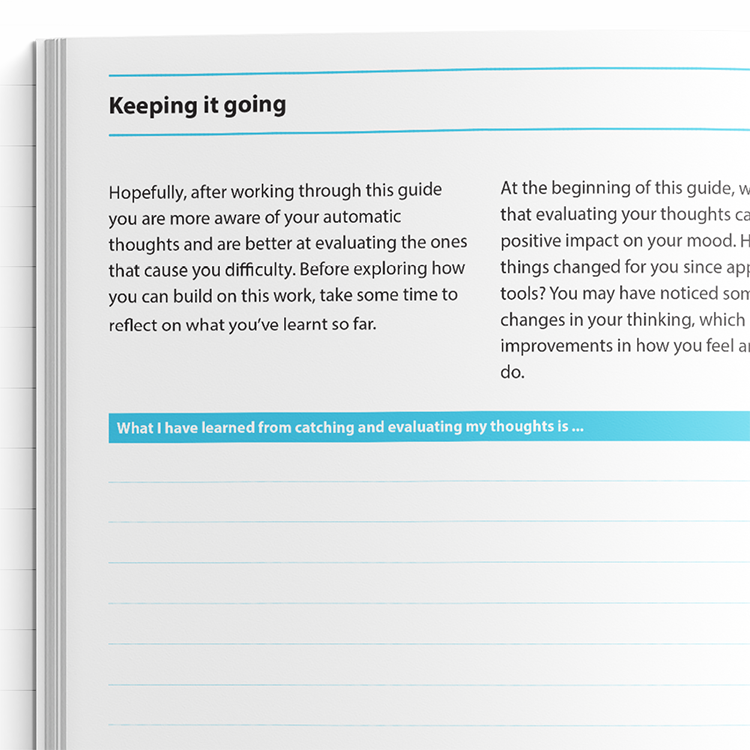Workbook (PDF)
A workbook containing elements of psychoeducation and skills-development.
A comprehensive guide to evaluating unhelpful automatic thoughts, written specifically for clients.

A workbook containing elements of psychoeducation and skills-development.
To use this feature you must be signed in to an active account on the Advanced or Complete plans.

The Evaluating Unhelpful Automatic Thoughts guide is written for clients who struggle with negative automatic thoughts. It provides a comprehensive introduction to what thoughts are, and how they can be linked to feelings and behavior. It also teaches fundamental cognitive behavioral therapy (CBT) skills, including how to identify and evaluate automatic thoughts.
This guide aims to help clients understand and address negative automatic thoughts (NATs). It explains what NATs are, how to identify them, and ways to re-evaluate them.
Clients experiencing negative thoughts that lead to low mood.
Thoughts focusing on potential threats and dangers.
Persistent self-critical or deprecating thoughts.
Identify clients who experience unhelpful automatic thoughts.
Introduce the guide to clients who could benefit from it.
Use the content to explore and normalize clients' patterns of thinking.
Use the exercises in the guide to help clients address their negative automatic thoughts.
Thinking allows people to plan, solve problems, create, or imagine, but it can cause problems when it leads to excessive worry, rumination, or self-criticism. Clients may often feel distressed or overwhelmed by their thoughts, and problems like anxiety, depression, low self-esteem, paranoia, and even reactions to physical pain can be the result of particular ways of thinking.
People often assume that the way they think is accurate, but in reality, thoughts are not facts. Thinking isn’t always slow or deliberate. In fact, it mostly consists of quick, automatic thoughts, which are called negative automatic thoughts (or ‘NATs’) when they cause distress. These thoughts may not be accurate, and are simply ‘best guesses’ or ‘opinions’ about the meaning of events. In this way, biases (typically called unhelpful thinking styles or cognitive distortions) can influence how people think.
While it may not be possible to prevent automatic thoughts, clients don’t have to accept them at face value, and can learn to interpret events differently. One of the best ways for them to do this is by learning to evaluate their thinking.
This guide is written for clients who are struggling with negative automatic thoughts. As well as providing a comprehensive introduction to the link between thoughts, feelings, and behavior, it teaches fundamental CBT skills including how to catch automatic thoughts, spot unhelpful thinking styles, and evaluate the evidence for and against automatic thoughts.

Just enter your name and email address, and we'll send you Evaluating Unhelpful Automatic Thoughts (English US) straight to your inbox. You'll also receive occasional product update emails wth evidence-based tools, clinical resources, and the latest psychological research.
Working...
This site uses strictly necessary cookies to function. We do not use cookies for analytics, marketing, or tracking purposes. By clicking “OK”, you agree to the use of these essential cookies. Read our Cookie Policy